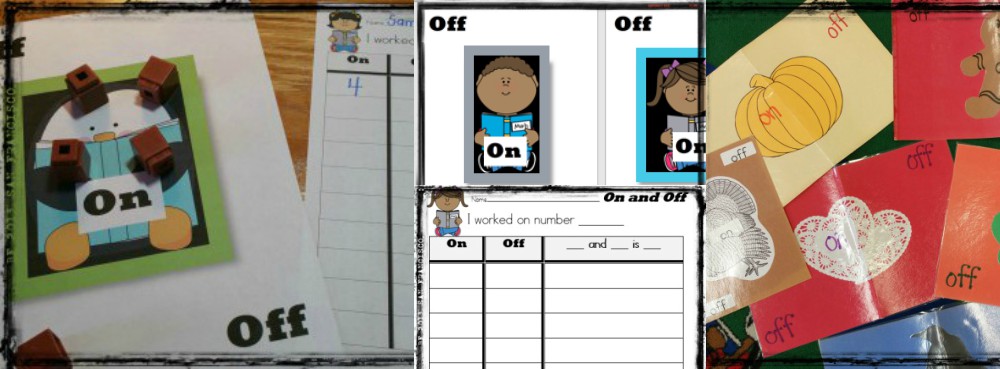Show a domino with 4 pips and 3 pips and ask a kiddo, “How many pips are on this domino altogether?” and watch quietly. This task will tell you so much about their number concept and how they combine quantities. Did they count all of the pips 1, 2, 3, …7? Did they bob their head? Did they point to each pip? Did they count their fingers? Did they say 4… 5, 6, 7? Did they say 3… 4, 5, 6, 7? Or did they immediately say, “7”?
Conceptual subitizing is the business of a kiddo demonstrating their knowledge of counting, manipulating quantities, and applying this knowledge in  problem solving. Doug Clements’ article, “Subitizing: What is It? Why Teach It?” does an awesome job of explaining the importance of this skill in mathematical development. I have seen that one of the keys to number sense development is practice, practice, and more practice. Kiddos need many, many opportunities to build a quantity and take the quantity apart in various ways. The goal is for kiddos to automatically compose and decompose numbers to ten and then from that point build place value knowledge.
problem solving. Doug Clements’ article, “Subitizing: What is It? Why Teach It?” does an awesome job of explaining the importance of this skill in mathematical development. I have seen that one of the keys to number sense development is practice, practice, and more practice. Kiddos need many, many opportunities to build a quantity and take the quantity apart in various ways. The goal is for kiddos to automatically compose and decompose numbers to ten and then from that point build place value knowledge.
So here’s a game that takes very little prep.
On and Off
First, I use the tried and true “Hiding Assessment” from Math Their Way (See Chapter 7 pg 186-187, I wish I could have met Mary Baratta-Lorton.) to determine what number the kiddo knows all of the combinations for and then work on the next number to master all combinations for building 0-10.  For example, if the kiddo hands me a total of 6 cubes and I show them 2 cubes, and ask, “How many are hiding?” Will they know quickly, easily, that 4 are “hiding”. Then, if they’re shown 1 cube, will they say 5 quickly, easily.
For example, if the kiddo hands me a total of 6 cubes and I show them 2 cubes, and ask, “How many are hiding?” Will they know quickly, easily, that 4 are “hiding”. Then, if they’re shown 1 cube, will they say 5 quickly, easily.
Supplies:
1. game boards- 9 x 12 or 18 x 24 construction paper My game boards are theme based, just because that’s how my primary mind works. Die-cuts, bulletin board characters, notepads, or shapes will work. I like to change out the boards monthly. But, feel free to use any picture that speaks to you and your kiddos.
2. “On” and “Off” labels (1 strip to cut and glue or 1″On” and 2 “Off” labels for each kiddo), or marker to write “On” and “Off”
3. items to toss ~ counters, cubes, pennies, paper clips, beans, or plastic lids I like items that can fit in the kiddos hands to gently toss in the air.
4. recording sheet To record their combinations. It’s funny to watch them be surprised when they get a combination, say 2 and 3 and then get the same combination 2 and 3 again. This response totally proving their need for practice to internalize the combinations. Even when their fine motor is shaky and their number to work on is 2, I give a recording sheet to provide meaningful number writing practice and introduce notation to show combining.
 How to play:
How to play:
Lay the game board flat. Get the amount of items to match the number you’re working on. Toss the items gently. Count and record
the number of items that land “on” the picture/shape. Count and record the number of items that land “off” of the picture/shape and construction paper. Since there isn’t a lot of room at their tables, I’ve found that focusing on whether the items are on the picture/shape, whether than just on the paper keeps kiddos from tossing too high and wild.
Since it’s individualized, all students can use it. This game has served us well for Parent/Child Make and Take Math Nights. 🙂 It’s a grand time to demonstrate the “Hiding Assessment” and emphasize that it can be done periodically at home so they can have an idea how their kiddo is progressing. Prepare a shape or character for them to cut out and glue, construction paper, strip (1 strip to cut and glue), labels (1 “On” and 2 “Off” labels for each family) or markers. For the tossing items, use what ever items you have an abundance of, for some reason my campus has been breeding unifix cubes. Provide a couple of recording sheets per family, but demonstrate how easy it would be to turn any piece of paper into a recording sheet.
Subitizing With On and Off Packet Contains:
3 Gameboards
30 sets of “On and Off” Labels
4 versions of Recording Sheets

Here are two First Grade Teachers demonstrating their version of “On and Off”.
Have fun playing On and Off and building that number concept!!
Until next time,


